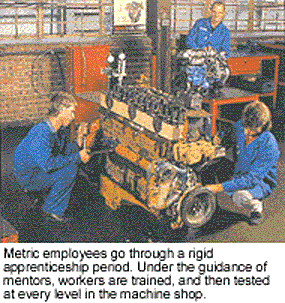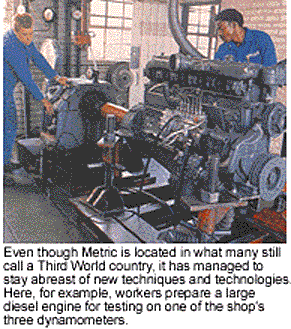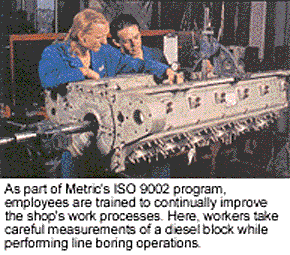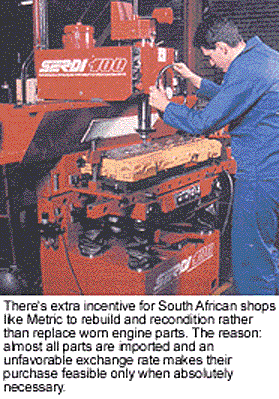Each year, the staff at Automotive Rebuilder magazine recognizes one machine shop that displays business practices that go above and beyond the norm. This year, along with input from the Engine Rebuilders Association (AERA), we have selected Metric Automotive Engineering (Pty) Ltd., from Germiston South, Republic of South Africa. Metric was chosen from numerous entries received from four countries including the U.S.
As always, this distinguished award was handed out at the annual AERA EXPO ’99 International held this past April 30-May 2 in St. Louis, MO. In front of their industry peers, Darryl Yorke, managing director of Metric, along with his son Andrew, was presented with a check for $500, plus additional prizes that included airfare, hotel accommodations, and a free copy of PROSIS® ’99 software from AERA.
With that said, the following is a firsthand look at the challenges encountered by engine rebuilders in the Republic of South Africa. Through the years, a non-democratic, pro-apartheid government had managed to severely limit the country’s free enterprise system. Today, however, a new democratic government is in place that for the first time has allowed Metric to think beyond the boundaries of South Africa, and join the global economy.
Again, our congratulations go out to Darryl Yorke and the employees of Metric Automotive Engineering for their fine achievements and participation in this year’s Machine Shop of the Year Award contest.
First steps were the hardest
The year was 1969. While here in the U.S. all eyes were on Neil Armstrong’s historic first steps on the moon, thousands of miles away in a small South African town, one man took a smaller, less conspicuous step into uncharted territory.
 His name was Lindsay Yorke, a transport manager by trade. If there ever was a bad time to start a machine shop in South Africa, this was it. "When my father opened the business the general economic structure was in shambles," explained Darryl Yorke. "The economy had overheated, the stock exchange had just collapsed, the bottom dropped out of the real estate market and most people had little money to spend on anything.
His name was Lindsay Yorke, a transport manager by trade. If there ever was a bad time to start a machine shop in South Africa, this was it. "When my father opened the business the general economic structure was in shambles," explained Darryl Yorke. "The economy had overheated, the stock exchange had just collapsed, the bottom dropped out of the real estate market and most people had little money to spend on anything.
"However, being the optimistic person that he was, my father had two things working in his favor. First, in these types of economic conditions, people tend to repair rather than replace engines, and second, if you can survive under these circumstances, you can survive anything."
Where they stand today
Survive they did, so much so that Metric is today one of the most respected engine rebuilding operations in South Africa, if not the whole continent. Specializing in the rebuilding and refurbishment of diesel engines and components, Metric is based some eight miles east of the city of Johannesburg in the industrial hub of the Witwatersrand goldfields.
Metric Automotive Engineering is housed in a custom-designed building together with its subsidiary, Reef Fuel Injection Services, which caters to the fuel injection needs of many of its customers. The company is a comprehensively equipped machining facility that is capable of rebuilding engines of up to 500 hp. The services offered by the company include: cam grinding; crank grinding; line boring; connecting rod machining; cylinder head reworking; reboring; milling; honing; and engine assembly.
 In addition, the company also owns three dynamometers, the largest of which is a 900 hp Heenan & Froude, which are used for in-house and "for-hire" testing by outside companies.
In addition, the company also owns three dynamometers, the largest of which is a 900 hp Heenan & Froude, which are used for in-house and "for-hire" testing by outside companies.
In terms of monthly production, Yorke said that Metric concentrates mostly on large diesel engines, although they occasionally work on smaller diesels like Isuzu and Nissan. "We do approximately 30-40 complete engines per month, with a normal turnaround time of about seven days," Yorke said. "Aside from these, we do quite a bit of rebuilding work on individual parts."
This monthly rebuilding work includes: 60 crankshafts; 75 rebuilt blocks (bore, hone, mill and counterbore); 70 line bore and line hones; 60 reconditioned connecting rod sets; 160 cylinder heads, most of which are cast iron; and 40 dynamometer tests. Yorke stressed that these are approximate figures, but largely represent Metric’s monthly averages.
Yorke added that the company employs 45 people on premises, including administration and sales staff who are responsible for serving both Metric and Reef Fuel Injection Services, as well as an associated company, Diesel Power Components, that supplies diesel engine parts to select clientele.
As far as his customer base is concerned, Yorke stated that many things are changing due to the new democratic government. Up until now, South Africa has had to establish and rely upon a strategic diesel plant called Atlantis Diesel Engines (ADE).
"ADE was licensed by Perkins and Daimler Benz to build engines for the local market under the threat of embargo during the apartheid era," Yorke explained. "That threat has now disappeared and ADE is being phased out. Now we anticipate an influx of many new foreign power units that will necessitate the use of new technology and training.
"Our other major customers have been the local OEMs," Yorke said. "Komatsu, for instance, has seven international remanufacturing facilities. The U.S. plant is in Lexington, KY. The African operation is just five miles up the road from us. Although the business has been good, Komatsu has been restricted from bringing in much business from other parts of Africa due to the anti-democratic government.
"Now that other African nations accept us as a viable trade partner, Komatsu and others will be able to import much more business to our region. This is also true of our other customers like Caterpillar and Cummins. Business should only get better as a result of the governmental changes," Yorke said.
The next major customer base for Metric is civil engineering contractors in the region, according to Yorke. Aside from doing the engine overhauls, Metric’s Reef Fuel Injection Service often assists with the fuel pumps, injectors and dynamometer testing.
 When asked what type of service intervals are normal for the heavy-duty diesel engines that they service, Yorke explained that his region has its own unique requirements. "Traditionally with earth moving equipment, the engine requires overhauling every 20,000 hours," Yorke said. "For over-the-highway use, it’s more like 500,000 miles. These seem to be the warranty periods offered by the OEMs on most of the newer engines.
When asked what type of service intervals are normal for the heavy-duty diesel engines that they service, Yorke explained that his region has its own unique requirements. "Traditionally with earth moving equipment, the engine requires overhauling every 20,000 hours," Yorke said. "For over-the-highway use, it’s more like 500,000 miles. These seem to be the warranty periods offered by the OEMs on most of the newer engines.
"However, whatever is acceptable in Europe and the U.S., you can halve here in South Africa. For starters, we operate locally at 6,000 feet with high ambient temperatures. Therefore the engine is stressed to try to obtain the output it was designed for at sea level at normal ambient temperatures. This doesn’t lend itself to a long service life."
Yorke also said that, generally speaking, service and maintenance procedures in South Africa leave a lot to be desired. Lack of adequate training for the drivers and operators also leads to abuse. Of course, there are pockets of excellence where operators are on par with the rest of the world, but these are the exception, rather than the rule according to Yorke.
Secrets to success
Like most thriving companies, success comes as a result of hard work and strategic planning. This is especially true of Metric where operationally, they have managed to carve out a niche in the large end of the diesel market.
"We haven’t been shy about developing our market," Yorke said. "We do large, heavy-duty diesel engines, and we do them well. We’ve made the investment in state-of-the-art equipment; in fact, we have the very first AMC 2800 and the only Rottler F88 in Africa. Plans are currently underway to acquire another Rottler F-Series to accommodate our automatic line boring operations."
Metric has also been very active in investigating new remanufacturing techniques including engine block reclamation, a process that Yorke first observed during a trip to the U.S. Because engine blocks can only be resurfaced one or two times when they’re rebuilt, they almost inevitably reach a point where they must be scrapped.
This new technology, developed by Caterpillar involves building up the face of the engine block by metal deposition and then machining it down to the appropriate specifications. Engine blocks the size of Cummins KT50C and Detroit Diesel 16V149 can be reclaimed using the process which, depending upon the condition of the old block, can realize a potential savings of 90% over the cost of a new engine block.
 According to Yorke the process is particularly beneficial in South Africa. "Current exchange rates make this a very attractive option," Yorke said. "Parts and components for heavy-duty diesel engines used in earth moving equipment, large trucks and mining machinery are all imported, so any form of local remanufacture or reclamation is advantageous because of savings on foreign exchange; our currency is very weak compared to the U.S. dollar."
According to Yorke the process is particularly beneficial in South Africa. "Current exchange rates make this a very attractive option," Yorke said. "Parts and components for heavy-duty diesel engines used in earth moving equipment, large trucks and mining machinery are all imported, so any form of local remanufacture or reclamation is advantageous because of savings on foreign exchange; our currency is very weak compared to the U.S. dollar."
Even though new techniques like block reclamation are profitable, Yorke maintains that Metric’s 1995 ISO 9002 accreditation forms the backbone of the company’s success. "This quality system is extensively used as a management tool to ensure that the highest standards are consistently maintained," Yorke said. "At this stage, only 12 of approximately 500 rebuilders have achieved this quality listing in South Africa.
"While all of the elements have to be observed, we pay particular attention to certain areas. First, the staff has been trained to submit corrective actions, non-conformances and deviations immediately. Management and subsequently the entire workforce review these submissions. The submission stays live until a resolution has been made. Basically, we never stop improving our processes around here," Yorke concluded.
Yorke added that the ISO 9002 accreditation also calls for the calibration of equipment at regular six-month intervals. "This is something that most machine shops wish to do, but often can’t find the time to do. Now we regularly contract out for these services and the results in improved efficiency and accuracy more than pay for the process."
Working in tandem with the ISO 9002 program is a strict workflow, work order and customer complaint system. Metric’s floor plan was designed to coincide with the logical flow of work through the shop, i.e., the receiving area is near the disassembly area, which is within close proximity to the cleaning area, etc.
"We don’t just pay lip service to this process," Yorke emphasized. "It’s all written down and worksheets must be followed and filled out by the employees so that no step in the process is overlooked. For example, if a crankshaft gets to the grinding station without the appropriate documentation from the crack test, it goes back to that station before it’s worked on further.
"If it seems like more work than is needed, just wait until that crank fails in a customer’s earthmover 500 miles from nowhere. We’re happy to spend a little more time to guarantee that mistakes don’t happen. In fact, all of our work is backed by a one-year, 60,000 mile warranty."
Metric also has a formal process for handling customer complaints. "This way, problems are always addressed with everyone’s knowledge and input. The process almost always produces an appropriate remedy, and customers feel like their concerns are taken seriously when they see the system in action."
Trained to succeed
Unlike in the U.S., apprentice training programs are a high priority in South Africa. According to Yorke, this progressive and proactive approach has enabled Metric to maintain its staff profile for the past 20 years without having to employ additional qualified personnel from outside.
"There is a massive unemployment problem in South Africa," Yorke stated. "Currently, the figure is close to 40%. This is aggravated by poor educational standards. We feel the key to our successful training program is the program itself, followed by careful selection of suitable candidates."
The company’s workforce is all trained in-house and falls under two general categories. An "operative" is a worker who is trained to operate a maximum of two machines. He has usually graduated from a general laborer to a position where he assists a qualified worker. To qualify as an operative, the worker does not require a minimum education or formal training, and neither does he undergo a qualifying test.
Next up the ladder is a "qualified journeyman." This worker is required to have a minimum of three years of high school education and is also required to sign a formal contract of apprenticeship in which he agrees to work for the company for a four-year period. The company is responsible for training him, and ensuring that he attends formal classes at a technical college for a period of three months every year.
To move up within the company, workers must follow a pre-determined path as directed by the Motor Industries Training Board, the South African entity responsible for apprentice training. The Board, in cooperation with machine shops like Metric, has divided the machining operations training into four sections referred to as levels. Each level is divided into a number of modules and each module has a written learning guide which sets out the learning objective of the module, as well as what is required of the apprentice.
The Board has qualified the existing journeymen at Metric as mentors. These mentors assist and test the apprentice during each module. When the apprentice has completed all the modules in a level, as well as a minimum time period in that level, he may request a "level test" which is administered by his mentor and overseen by an individual from the Board.
If he is successful, he receives a pay increase and moves on to another level (activity) in the workshop. If he fails, he has two more opportunities to attempt the test. If he fails on all three occasions, he is disqualified from the balance of the course.
This modular training system, which is time and skills based, maximizes productivity and prevents workers from becoming stagnant in the workplace. It also serves as a pretty good barometer as to the talent and fit of new workers, according to Yorke.
"After machinists go through our training modules, both the employer and the employee have a good idea whether they’re satisfied with the performance," Yorke said. "In most cases, these individuals come out as proficient all-around journeymen."
Yorke went on to add that higher education is encouraged at other levels as well. Metric regularly finances courses pursued by employees, provided these courses are relevant to the company’s activities. In addition, the company sends employees to first aid courses, AIDS awareness seminars, safety courses and ISO 9002 seminars, as well as training programs related to the functioning of the free enterprise system.
The typical workweek at Metric is 45 hours and consists of just one shift per day. According to Yorke there are 14 paid holidays per year and every employee receives three weeks vacation. After 10 years of service, employees are entitled to four weeks of paid vacation.
"Our goal is to provide a comfortable and fair working environment in which employees are given the opportunity to grow," Yorke said. "In addition to our paid leave, we’ve also instituted long term, tax effective insurance policies which will, after 10 year’s service, provide employees with a tax-free cash pay out, and will continue to do so at successive five-year intervals. This has worked well to encourage long term service from our employees."
Beyond the shop floor
Perhaps because of their less than ideal political environment, Metric realized that there was a great need for external networking. Today, representatives who are responsible for calling on both new and existing customers market their services. In addition, the company employs the services of a public relations agency that is responsible for ensuring editorial representation in the local trade and technical press.
Metric regularly donates engines and instruction to local schools, and according to Yorke, periodically trains technicians who work for their customers. "When training apprentices, many customers don’t have the specialized equipment needed to do the job properly," Yorke said. "Especially diesel mechanics who require a working knowledge of micrometers and fuel injection. We’re happy to provide these at no extra charge because ultimately it benefits everyone involved."
In terms of organizational involvement, work undertaken by Metric is organized under an umbrella body called The Motor Industries Federation. This body comprises 16 constituent members, ranging from panel beating and parts suppliers to new car sales companies, and is responsible for protecting the interests of all parties. The Motor Industries Federation takes up major issues with the government or unions on behalf of its constituent bodies, one of which is the Engine Remanufacturers Association (ERA).
Yorke is currently the vice-chairman of the regional ERA division. In addition, Metric has been a member of AERA for the past six years and regularly sends representatives to the Expo and Tech Shows. Such visits are often combined with other training seminars for technicians, as well as factory visits to other AERA members who have been more than willing to exchange information and ideas.
Conclusion
With all the differences that have been pointed out between engine machine shops in South Africa and the U.S., it’s amazing how many similarities still exist.
Perhaps Yorke said it best when he observed, "What amazes me the most is how similar the problems and opportunities are for machine shops worldwide: finding and keeping good people; keeping up with OEMs; and making every billable minute count. It’s really that simple – whether you’re in Germiston South or Germantown, PA."













